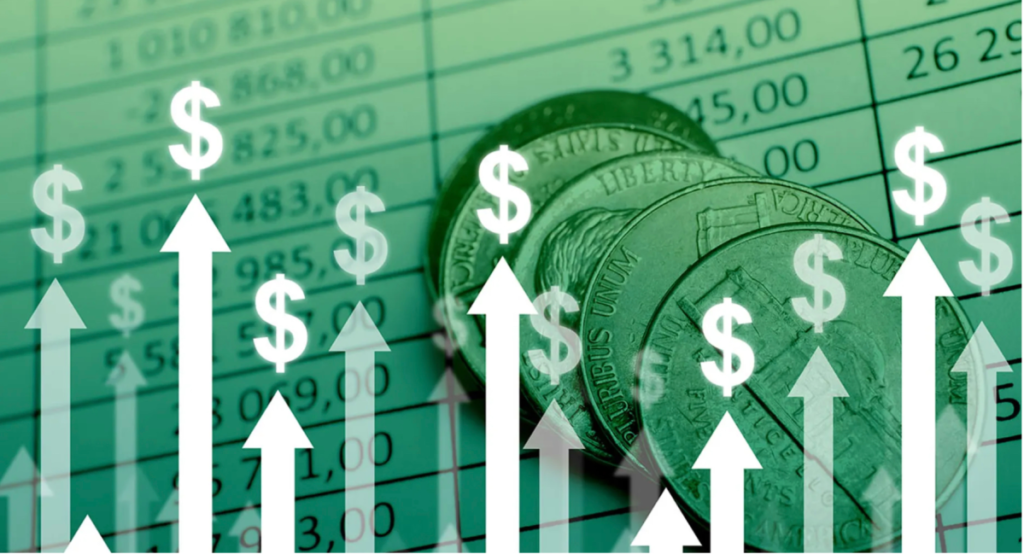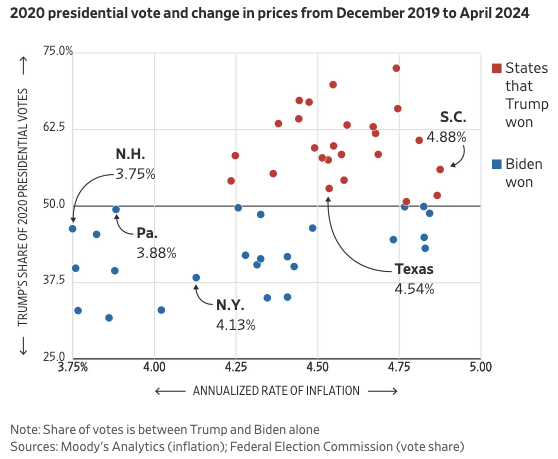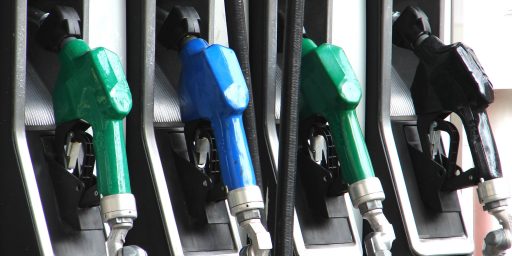Republicans Expect and Experience Higher Inflation than Democrats
A weird report might explain a puzzling finding in the polls.

Justin Lahart, WSJ (“Trump Voters Don’t Just Expect Higher Inflation—They Get It Too“):
Republicans right now think inflation is a much bigger problem than Democrats do, and a lot of that is just politics. But here’s another possibility: Many of the places Republicans live indeed have had significantly higher inflation than Democratic enclaves.
In new research, economists Carola Binder, Rupal Kamdar and Jane Ryngaert examined Labor Department inflation figures for U.S. metropolitan areas, and compared them with voting data. Their finding: Metro areas with more Republicans and independent voters tended to have higher inflation in 2022 than places where Democrats live.
A Wall Street Journal analysis found a similar pattern at the state level. Inflation estimates provided by Moody’s Analytics, combined with voting data, show that states where Donald Trump garnered the most votes in 2020 have on balance experienced higher inflation.
For example, South Carolina experienced the most inflation of any state since the pandemic hit. Its consumer prices rose at a 4.88% annual rate between December 2019 and last month. South Carolina elected Trump with 56% of the votes cast between him and President Biden in 2020.
In contrast, New Hampshire had the least inflation of any state, with prices rising at a 3.75% rate. It elected Biden with 54% of the Trump/Biden vote.
And, no, it’s not just those two states:

The infographic is a bit weird, in that the rate of inflation isn’t dependent on Trump’s share of the vote and the clustering looks artificial. Still, almost all of the states that went for Trump are in the right quadrant.
So, what’s the explanation for this?
Just as importantly, Binder and her co-authors found that people in Republican-leaning states were more likely to expect that higher inflation. While feelings might seem superfluous, economists and policymakers widely believe that expectations do matter. If people think more inflation is coming, that can lead to higher inflation in fact.
That seems counterintuitive but so do observer effects. And it may well be that an expectation of inflation gives businesses more latitude to raise prices.
Other explanations make more sense:
Moody’s Analytics chief economist Mark Zandi reckons that part of what drove inflation higher in Republican-leaning states was housing—especially with so many people moving South after the pandemic started.
“You saw significant out-migration from the Northeast and the West Coast to the South and the Mountain West that tend to be more Republican,” he said. Rents, in particular, shot higher, and rents and rent-derived measures count for about a third of the spending basket the Labor Department uses to calculate inflation.
I’m skeptical that the pattern was uniform but sure.
People in Republican-leaning states also tend to devote more of their spending to gasoline, so the steep run-up in gasoline prices into 2022 probably affected them more. Also, gasoline can play an outsize role in people’s view of inflation—it is a frequent purchase, and the price is right there on the pump.
Again, I don’t know that this is uniformly true but, yes, people in rural areas use more gas than those who live in cities.
But then they circle back to expectations:
But Binder and her co-authors posit that expectations helped push inflation higher.
The theory that beliefs about inflation matter was cemented following America’s painful experience in the 1970s. The more inflation businesses expect, the more they will raise prices in an effort to get ahead of rising costs. Similarly, workers will demand bigger wage increases if they expect more inflation, pushing labor costs higher.
Fed officials spend a lot of time talking about the importance of keeping inflation expectations anchored to keep prices from spiraling higher. And for Democrats, expectations were in fact anchored, maybe because they bought into the Fed’s belief that the recent burst in inflation would prove transitory.
“But people who didn’t believe that narrative, they saw inflation rising and they extrapolated that forward and their expectations rose,” said Binder, author of the new book “Shock Values: Prices and Inflation in American Democracy.” “And that in turn kept inflation rising more than it otherwise would have.”
In October 2022, when inflation was running hot, Republicans in the Michigan survey said they expected prices to increase by 7.6% over the next year, versus 3.1% for Democrats. Even though inflation has since moderated, the gap remains wide: This month’s survey showed Republicans expect 4% inflation, compared with 2.2% for Democrats.
This is all based on a single report, albeit one for the National Bureau of Economic Research.
Skimming the report itself, the co-authors highlight the fact that Democrats and Republicans tend to consume different news sources. Fox, not shockingly, has pushed the bad economy narrative pretty hard, which would certainly add fuel to the “expectations” argument for Republicans.
Additionally, they note (pp 17-18) both “Realized MSA level infl ation was higher in more densely Republican and Independent MSAs” and “Prior to the COVID-19 pandemic, in flation was lower in less heavily Democrat areas. In the post-pandemic period, this relationship reversed.” So, it’s a double whammy. Not only is inflation actually higher but it feels way higher because it’s so unusual.





As I approached early retirement, one of the tasks was to calculate a “personal inflation rate”.
For example, rent increases are irrelevant to me, as are mortgage rates because we own our home. We purchase 8 gallons of gasoline every six weeks, etc.
But food, medical expenses, and utilities affect our budget as much as anybody.
Rural folks and Republicans in general tend to shun things like solar panels and efficient vehicles. Stereotypically they eat more meat (specifically beef) than the average American. They probably smoke cigarettes more than average.
So yeah, their personal inflation rate is likely higher due to the choices they make.
As usual, however, they want to blame somebody else for the outcomes that come from their personal decisions.
Nothing to see here.
Well, using the general CPI at the BLS calculators, $100 in January 2021 bought what you need $120 in April 2024.
In contrast, $108 in January 2021 bought what $100 bought in January 2017.
People notice a 20% decline in purchasing power, especially when it hits them in the face. And CPI excludes things people actually use like, food and energy.
Not to mention inflation is always going to be higher in places where the population is growing compared to those losing population.
I also found it interesting that searching for “California” in the report came up with no matches.
This is fascinating.
The paper uses CPI as their measure of inflation. The components of CPI in decreasing order of weight are:
Housing (including rent and utilities)
Transportation (including gasoline)
Food and beverage
Medical care
Education and communication (a weird bucket)
Recreation (entertainment)
Other
For some of those, there are identifiable differences between Republican-run states and Democrat-run states. A large component of gasoline prices are state taxes, which are larger in Democrat-run states and thus provide a control mechanism in times of price escalation — the state can adjust the taxes to reduce the impact at the pump. You can’t really do that if the taxes were low to begin with.
For medical care, GOP policies have been driving medical service providers away since Obamacare was passed, and recent anti-abortion craziness has accelerated this. I could easily believe that the cost of medical care is growing faster in GOP areas than in Democratic areas.
The effect of migration on rents and home prices was noted, but it’s also true that rent controls are much more likely to exist in Democrat-run places.
I suspect that there is also a social aspect here. My wife made the interesting point that one’s perception of the severity of inflation is partly mediated by your willingness to substitute out of the goods and services that are increasing the most in price. If you continue to eat beef, even as it doubles in price, rather than eating more chicken or pork, you will experience higher inflation than your neighbor who substitutes. If you continue to drive the same number of miles per month, etc. It would be fascinating to know whether there is a measurable difference in willingness to substitute between GOP states and Democratic states.
@JKB:
Yes, it would have been a better paper if the authors had included state population growth rate as one of their predictors — both for actual inflation and for inflation expectations.
I find the paper’s focus on expectations (as opposed to differences in actual inflation experience) frustrating and inexplicable. They wrote the second (or third) paper before writing the first one.
@JKB:
I’m breaking my own rule to respond to you. You’re an idiot. Wages have outpaced inflation since 2021. Be better.
https://www.statista.com/statistics/1351276/wage-growth-vs-inflation-us/
@EddIeInCA:
Yes, but — I could easily believe that wages have kept pace better in Democrat-run states than in GOP-run states. Differences in labor union participation and “right to work” laws might account for it, all by themselves.
It’s starting to sound like greater loss of buying power is a self-inflicted wound, voted for repeatedly by the affected populations.
Is age a factor? I’m old and simply buy less stuff than when I was younger. I’m not buying new housing. I drive an eight old Nissan that should last another eight years. I’m driving less, and it’s all discretionary. Not buying fashionable clothes. On generic meds. I wonder if a younger demographic that needs to buy more housing, transportation, and garments feels inflation more than oldsters.
I lived through the Johnson, Nixon, Carter, Reagan inflation. That expectations drive inflation was and is a commonplace, as noted further down the post. Are expectations sufficient to explain the regional differences? I don’t know. I do know that in my little corner of FL people seemed to almost enjoy higher gas prices so they could bitch about it and slap pictures of Biden saying “I did that” on pumps.
@Slugger: Age is a factor.
@JKB: I am reluctant to respond to your inanity, but at least let me clarify that
is baloney.
As DrDaveT notes in the subsequent post food and energy *are* a large part of the CPI. Now for “Core CPI” they are excluded but that is not what you said.
Interesting little chart with a modicum of significance. If you exclude some Northeastern states, the difference between states is at most .75%. That is statistically significant for sure but I would not consider it to have a significant economic impact. Why is the NE different? Like all things involving economics, there are probably multiple factors. For example, gas is more expensive in the NE, so if gas goes up a quarter a gallon, the inflationary impact as a percentage would be less. For the record, there are two main values of inflation CPI and CPI minus energy and food, in the mid and long term CPI values track all inflation, but the reason for the adjustment has to do with volatility, nothing more, nothing less. In the long run both track the same. Now, many economist have been questioning the Feds value of shelter as not reflective of real life. Renting prices are weighed differently than mortgage prices ostentatiously because the latter represents asset growth which is correct, the problem is that for the consumer, both impact the cost in the same manner from an out of pocket point of view. Someone will have to figure out how to make some sort of adjustment. As it stands, the current method tends to exaggerate inflation by over 1% (mortgage prices tend to be more stationary than rents and are not factored in the computation). As to inflation expectations, it is a psychological truism that one drives the other (what that means in real life is that if one expects higher prices one is willing to pay for higher prices- we see this everyday in consumer choices).
@Raoul:
My instinct – based on nothing, hence ‘instinct’ – is that the data, and especially the interpretations of same, are mostly bullshit.
On the one hand, this plays to my strong bias that most of what is called economics is just a branch of social psychology.
On the other hand, I guess I look at the chart and see something different than red vs blue.
You have 41 states clustered together between ~4.25% and ~4.8%. This includes all of the R states and most of the D states that are distributed across the range.
Then you have 9 outlier states – all D states – from 3.75 – 4.13%. So the question in my mind isn’t so much about Republicans vs Democrats, but what is it about those 9 states that resulted in lower annualized inflation? Is it really because they vote majority Democrat or is there something else that explains it? Because if it’s the former, then I would expect the other D-majority states to be down there with them and not basically in the same range as the R states.
@Michael Reynolds:
In my experience as a scientist, consistent <0.5% differences just don’t happen. I was going to be charitable and assume this is real data, but this plot is not from the academic paper but from the WSJ. A quick dive shows it’s from Moody’s analytics, estimated from BLS metro data (see here). I call bullshit.
Republicans refuse to contemplate the reality that the reason “Things Cost So Much” is the owners of the companies in their area. It’s not Supply Chain, it’s not Chiiiina, it’s not Furriners Taking Our Jobs, it’s not Biden, it’s not Illeegal Immigrants…… it’s greedy local company owners raising prices because they can, full stop. Republicans have the idea that “owners will always get theirs” and so… stuff like this has happened and will happen.
Because Fox/Newsmax/etc will always assert the reason is something else, Republicans will never wake up.
You’ll barely see this story on other news orgs either because the owners of the paper&TV are part of the same economic class… Democracy dies in darkness when a pillow is held over its face by the Washington Post.
It’s metro areas rather than states themselves, so we’re talking about Philly and Pittsburgh versus Dallas, Houston, and San Antonio.
I think this is probably noise rather than signal, but if there’s a bit of signal it has to do with northeast cities not being run by boomtown logic.
From England, but still why inflation matters
I haven’t checked them out, but the stories are that McDonalds and other fast food has gone insane in price.
@JKB: Wait, I thought that it was socialistic governments in places like Cali and Orygun demanding that the WOGS get paid close to what rent costs that were making stuff unaffordable.